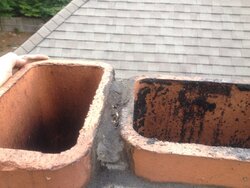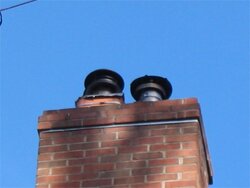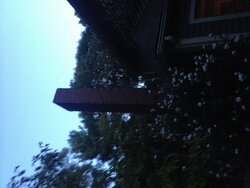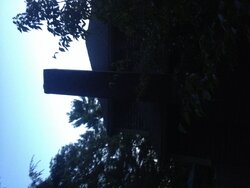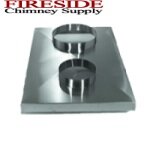Chimney cap?
- Thread starter Mrwinter617
- Start date
-
Active since 1995, Hearth.com is THE place on the internet for free information and advice about wood stoves, pellet stoves and other energy saving equipment.
We strive to provide opinions, articles, discussions and history related to Hearth Products and in a more general sense, energy issues.
We promote the EFFICIENT, RESPONSIBLE, CLEAN and SAFE use of all fuels, whether renewable or fossil.
You are using an out of date browser. It may not display this or other websites correctly.
You should upgrade or use an alternative browser.
You should upgrade or use an alternative browser.
- Status
- Not open for further replies.
hwdemers
Member
Looks like a newish roof, I'd go with one custom cap, would look a lot better, get a 10" or larger mesh. U t wouldn't be huge so it would be dealt removed for cleaning
Nick Mystic
Minister of Fire
Looks to me like you would have a hard time fitting two separate caps on those two flues due to how close they are to each other. I have three clay tile flues coming out of my chimney, but they are all farther apart from each other. The cap I have on mine would hit each other if they were on a set up like yours. If one of your flues is going to have a cap fastened directly to the clay liner and the second one was going to have a top plate with a cap sitting up higher off a flex liner, then you might be okay with separate caps, but not two caps that both fasten down just one the clay tile with set screws.
Ram 1500 with an axe...
Minister of Fire
Thank you all for your replys
Nick what you said is my problem . A two flue cap would look better, but all the caps I have seen online don't seem have a way to support the 6" liner .
Nick what you said is my problem . A two flue cap would look better, but all the caps I have seen online don't seem have a way to support the 6" liner .
Two caps. And make sure the one for the lowest terminating flue is shorter than the other one, which I assume will be attached to the insert. If not the basement or whatever is gonna siphon smoke/gases right down it due to negative pressure. Don't believe it, go down there and feel the cool air coming down the lowest opening.
We use multi flue caps all the time and have very rarly had an issue with smoke spillage in another flue. If there is an issue it is easily remidied by a stainless divider. And Mr winter you would use the top plate that goes to you liner to support it and then the cap would just attach to the masonry
Hogwildz
Minister of Fire
A few things.
Those clay liners should have been installed with a gap filled with an appropriate sealant between the clay liner and the chimney masonry & top cap. May not be a big deal, but this is technically how they are supposed to be built. If I am wrong someone please feel free to correct me. The excess mortar between the two looks like it is going to make it difficult to install separate caps. Since they are laid out in a "T" position, even a single cap may be difficult unless custom made.
Are both going to be in use(different appliances)? If so, one should be higher than the other to prevent reverse draft of exhaust from one to the other. If only one is going to be in use, you can cap the other one off(seal it at top with plate or some kind of tight cover) and then no need to have one higher than the other.
That mortar in between built up like that is concerning as to why it was built up that much?
Those clay liners should have been installed with a gap filled with an appropriate sealant between the clay liner and the chimney masonry & top cap. May not be a big deal, but this is technically how they are supposed to be built. If I am wrong someone please feel free to correct me. The excess mortar between the two looks like it is going to make it difficult to install separate caps. Since they are laid out in a "T" position, even a single cap may be difficult unless custom made.
Are both going to be in use(different appliances)? If so, one should be higher than the other to prevent reverse draft of exhaust from one to the other. If only one is going to be in use, you can cap the other one off(seal it at top with plate or some kind of tight cover) and then no need to have one higher than the other.
That mortar in between built up like that is concerning as to why it was built up that much?
I prefer a single cap made to the size of the chimney it keeps water off the top and extends the life of the masonry and yeah you are right hog there should be an expansion joint but i almost never see them. We do it when we pour a crown but most masons don't. There also is obviously no withe wall either which there should be
Good thoughts by all that have replied . Both flues are going to be used one for the boiler the other for the insert .
I under stand about the top plate going to support the SS liner, but I was wondering if I could do one cap but i think water would get in ,
Looking for the correct way to install but I want to have easy acess for inspection and cleaning . It seems that two individual caps is the way to go.
I under stand about the top plate going to support the SS liner, but I was wondering if I could do one cap but i think water would get in ,
Looking for the correct way to install but I want to have easy acess for inspection and cleaning . It seems that two individual caps is the way to go.
My liner was installed with a simple round cap fitted to the top plate, but I didn't like the look of a small round cap on a large rectangular chimney. Someone at work offered me a rectangle stainless cap that is attached to the clay tile, and although I have another unused flue only 1" away, fitting it was no problem and it looks much better. I did check that the clearance from the installed top plate to the top of the new cap was enough, i don't want to be obstructing flow. I looked into custom caps to cover the whole chimney top, but what I could find was $$$$.
TE
TE
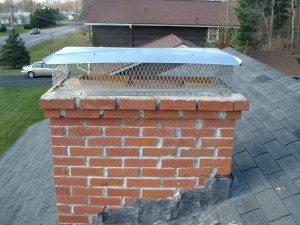
this is the type i am talking about just covers everything. they look good and keep water off the top
That's exactly what I wanted but the generic models are too low for a chimney with a liner, or at least for mine. Imagine those clay tiles with a typical top plate which protrudes 4-6" above the clay tile, the gap between the top of the liner and the cap is less than 6". That's getting to where it could impede airflow. Custom models were $1000+.
this is the type i am talking about just covers everything. they look good and keep water off the top
TE
We get them form olimpia and sell them installed for way less than that. Look around some more you will find them cheaper. You can also either cut down the top clamp or get a different type of top clamp that is lower. You will need at least a 12" high cap though.
Gelco make'em and lots of places on the web sell them.
http://www.efireplacestore.com/cpf-13230.html?productid=cpf-13230

http://www.efireplacestore.com/cpf-13230.html?productid=cpf-13230

yeah gelco makes good caps we use their clamp on ones. We just use olimpia for the multi flue ones because they do custom sized ones in under a week. Look around on the web you might find a standard size that is close enough just make sure it is 12" high or more
newatthis
Member
I have a question about the multi-flue spillage problem- if you choose to stagger the heights of the flues, which one should be the tallest, or shortest, to avoid CO getting sucked into the basement?
- Status
- Not open for further replies.
Similar threads
- Replies
- 4
- Views
- 628
- Replies
- 17
- Views
- 1K
- Replies
- 5
- Views
- 916
- Replies
- 1
- Views
- 194


